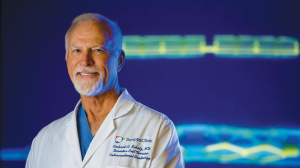Estate Gift Will Expand Opportunities
Richard Schatz, MD’77, was in California, just days away from returning to New York to begin his senior year as an undergraduate at the State University at Buffalo, when the phone rang and changed everything.
“It was Duke,” says Schatz, who is now research director of cardiovascular interventions in the Heart, Lung, and Vascular Center and director of cell therapy at the Scripps Clinic in La Jolla, California. “They said, ‘You’re on the wait list for medical school, and a spot just opened up. You have to be here in three days.’”
Schatz, with just three years of undergraduate work, had applied “on a whim” for early admission to Duke University School of Medicine. He packed his bags and caught the first plane back to New York, threw his stuff in his car, and headed south.
“I pulled into Durham and stopped at a fuel station and said, ‘Where is this Duke place?’” he says. “The guy says, ‘Down there, make a left.’ When I finally made it, I walked into the office and said, ‘Here I am. Where’s my dorm?’ They said, ‘This is medical school. We don’t have dorms.
Bit by bit, he figured it out. He worked hard, received a Davison Scholarship, and made his way into the labs of mentors including cardiologist Joe Kisslo, MD, and biomedical engineer Olaf T. Von Ramm, PhD’73.
That confluence of cardiology and engineering shaped his career. Schatz became a pioneer in developing cardiovascular interventions, and his seminal work on coronary stents spurred a revolution in the treatment of coronary artery disease. The modified design he patented in 1991 became the gold standard for every subsequent stent submitted for FDA approval. More than 2 million stents are placed annually worldwide, relieving mortality and morbidity, improving patients’ lives, and reducing health care costs.
That progress came in the face of many scientific, financial, and practical hurdles.
“There was only one way it could have worked and a hundred ways it shouldn’t have worked,” he says. “But we were able to navigate all that, and the stent we came up with continues to endure.”
For his breakthrough work in cardiovascular care, Schatz, along with John B. Simpson, MD’74, HS’75, PhD, and three others, was awarded the 2019 Russ Prize, awarded by the National Academy of Engineering and Ohio University for bioengineering achievements that significantly improve the human condition.
Schatz recently made a major estate gift to Duke to create the Richard A. Schatz, MD, Cardiovascular Research Endowment Fund and the Richard A. Schatz, MD, Student Research Endowment Fund. Those gifts continue Schatz’s long history of generous support for the School of Medicine. It’s all a way to give back, he says.
“I never would have achieved anything if it weren’t for Duke,” says Schatz. “They took a huge risk accepting me in the first place, and they prepared me to succeed. I want to help them give that opportunity to others.”
This story was originally published in the Spring 2019 issue of DukeMed Alumni News
Photo by David Poller



